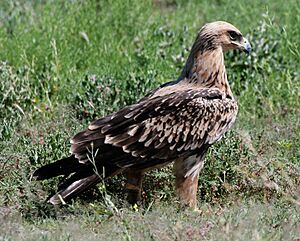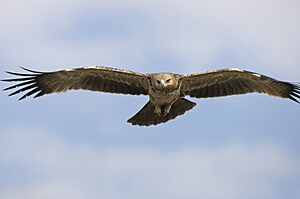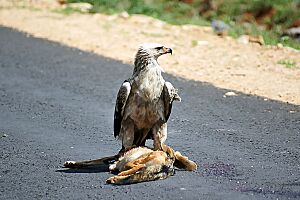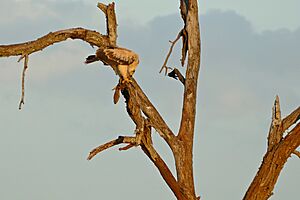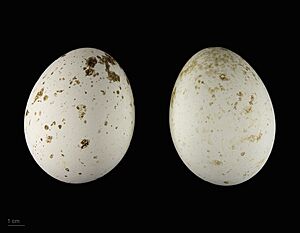Tawny eagle facts for kids
Quick facts for kids Tawny eagle |
|
|---|---|
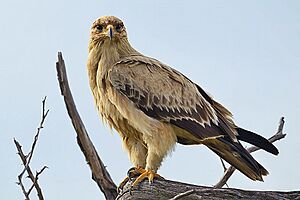 |
|
| From Etosha National Park | |
| Conservation status | |
| Scientific classification | |
| Genus: |
Aquila
|
| Species: |
rapax
|
| Subspecies | |
|
|
 |
|
| Range of A. rapax Resident | |
| Synonyms | |
|
Aquila rapax rapax |
|
The tawny eagle (Aquila rapax) is a large bird of prey. Like all eagles, it belongs to the bird family called Accipitridae. Its legs are covered in feathers, which means it's part of a group known as "booted eagles."
Tawny eagles live in many places, but not everywhere. They are found across much of Africa and the Indian subcontinent. You might also see a few in the southern Middle East. These eagles like open, dry places. They prefer semideserts, deserts, steppes, or savanna plains. Even though they like dry areas, they usually avoid places with no trees at all.
Tawny eagles stay in one place to breed. They build a stick nest in the top of a tree. They lay one to three eggs. These eagles are very clever at finding food. They often eat dead animals (called carrion). They also steal food from other animals, a behavior called kleptoparasitism. But they are also strong hunters and catch their own live prey. Tawny eagles can live up to 16 years.
Sadly, the number of tawny eagles is going down quickly. This is happening because their nesting places are being destroyed by logging and global warming. They are also harmed by poison and other human activities. These problems are pushing the tawny eagle closer to extinction.
Contents
About the Tawny Eagle Name
The tawny eagle was first described in 1828 by a Dutch scientist named Coenraad Jacob Temminck. The name "Tawny eagle" is its official name. The word Aquila is Latin for "eagle." The word rapax is also Latin and means "to grasp." It relates to the word "rapacious," which means very good at hunting.
The tawny eagle is part of the "booted eagle" group. This group is known for having feathers on their legs. Scientists study their genetics to understand how they are related to other eagles. The Aquila group usually includes large, dark eagles that live in open areas.
Scientists used to think the tawny eagle was the same species as the steppe eagle (Aquila nipalensis). But they are now considered different species. Steppe eagles are bigger and have a different beak shape. They also have different colors and habits.
Tawny Eagle Subspecies
There are three main types, or subspecies, of tawny eagles. They mostly live in different parts of the world.
- A. r. rapax: This subspecies lives in Africa, from the southern Democratic Republic of the Congo and central Kenya southwards. These eagles often have a reddish-brown color. Young birds are usually light reddish-brown.
- A. r. belisarius: This type is found in west Africa to Ethiopia and southwest Arabia. They might look a bit neater and duller brown than the other African type.
- A. r. vindhiana: This subspecies lives in Asia, like southeastern Iran and the Indian subcontinent. They are usually darker than the other types and look more like the steppe eagle.
What a Tawny Eagle Looks Like
The tawny eagle might look a bit "scruffy," but it has a unique shape. It has a long neck and a strong, deep beak. Its wings are long and wide, with distinct "fingers" at the tips. Its tail is short and rounded, almost like a vulture's tail. The feathers on its legs are very thick.
When it sits, the tawny eagle usually sits upright on stumps, posts, or low trees. It can also walk on the ground, though a bit unsteadily. Adult eagles have eyes that can be yellow, pale brown, or yellow-brown. Young eagles have dark brown eyes. Their beak area (cere) and feet are yellow at all ages.
Tawny eagles come in many different colors. They can be dark grey-brown, reddish-brown, or yellowish. Most adults are generally grey-brown or reddish-brown. Females are usually a bit larger and darker than males. The darkest eagles are often found in India.
When flying, the tawny eagle looks like a large bird with a long neck and broad wings. Its wing beats can look heavy and slow, but they are quick and agile when chasing other birds to steal food. They often fly with flat wings or slightly raised wings.
How Big are Tawny Eagles?
The tawny eagle is a large bird of prey. However, it's considered medium-sized for an eagle. It's one of the smaller species in its group, Aquila. Female tawny eagles are larger than males, but only by about 15%.
Tawny eagles can be from 58 to 75 centimeters (23 to 30 inches) long. A typical length is about 65 centimeters (26 inches). Their wingspan can be from 157 to 190 centimeters (5.1 to 6.2 feet). They weigh from 1.5 to 3.1 kilograms (3.3 to 6.8 pounds).
Similar Birds
The tawny eagle lives in many places where other large, brownish birds of prey are found. This can make it hard to tell them apart.
The steppe eagle is often confused with the tawny eagle. Steppe eagles are larger, have a shorter neck, and a bigger beak. They also have different wing patterns.
Other eagles can also look similar. For example, spotted eagles have shorter tails and less prominent beaks. Eastern imperial eagles are larger and have different wing shapes. The golden eagle is much bigger than the tawny eagle.
Tawny Eagle Calls
Tawny eagles are usually quiet. But they do make sounds sometimes, even when not breeding. Their main call is a loud, harsh bark. It sounds like "kowk-kowk" or "kau-kau." Males call more often, especially during their sky-dances. They also call during food fights or when disturbed at their nest.
Other calls include a harsh "k eke ke" during courtship flights. A throaty "kra" is used when stealing food. They might use a "kra-kra" call to warn others. Females might make a soft "shreep-shreep" at the nest. Young chicks make a "we-yik, wee-yik" sound when begging for food.
Where Tawny Eagles Live and Their Homes
Tawny eagles live in a very large area. In Africa, they are found in three main groups. One group is in North Africa, including parts of Morocco and Sudan. Another group is in west Africa. The third group is in east Africa and southern Africa. In East Africa, they are one of the most common brown eagles.

Outside Africa, they might be found in the southwestern Arabian peninsula. In Asia, they live in southeastern Iran and the Indian subcontinent. They are rarely seen in places like Myanmar or Thailand.
Tawny Eagle Habitat
Tawny eagles live in open, dry areas. In West Africa, they sometimes breed in wetter forest areas. But they prefer dry woodlands and semi-deserts when not breeding. In Morocco, they like forests near mountains with open plains.
They avoid very dry deserts with no trees. They also avoid humid tropical rainforests. They can sometimes be found near human areas like farms, roadsides, and even garbage dumps. In India, they often visit garbage dumps and slaughterhouses.
Tawny eagles need some rainfall to survive. This helps their prey populations and provides places for them to nest. They usually build nests in trees. So, areas where trees are cut down might lose their tawny eagles.
Tawny Eagle Behavior
Unlike steppe eagles, tawny eagles usually stay in one place. They don't migrate far. However, in Africa, they can move around seasonally. Some eagles might travel to damp woodlands in certain months.
Tawny eagles are usually solitary birds. But sometimes, groups of two or three are seen, especially in India. They might gather in small groups where there's a lot of food. Like many large birds of prey, they spend most of their day sitting on a perch. In India, tawny eagles are often used to humans and might let people get close.
How Tawny Eagles Find Food
The tawny eagle is special because it doesn't specialize in just one type of food. It's very flexible in what it eats.
Tawny eagles often eat carrion (dead animals). They do this all year, but especially when they are not breeding. They often go to garbage dumps and slaughterhouses, especially in India. They also eat roadkill (animals killed by cars). They often share these food sources with vultures.
Tawny eagles are also very good at stealing food from other birds of prey. This is called kleptoparasitism. They are known for being fearless when they do this.
But tawny eagles are also strong hunters. They attack many different kinds of live prey, sometimes even very large ones. They usually hunt by diving from a perch or from high in the sky. They often hunt prey on the ground. Sometimes, they catch birds in the air, like flamingoes.
Tawny eagles sometimes hunt in pairs, especially during breeding season. This helps them catch larger prey. They might work together, with one eagle distracting the prey while the other sneaks up. They have even been seen hunting at night. They also go to grassfires to catch animals trying to escape.
Tawny eagles eat over 200 different species of animals. This makes their diet one of the most varied among tropical eagles. They usually eat live prey that weighs between 125 grams (4.4 ounces) and 2.5 kilograms (5.5 pounds). But they can take much larger prey too.
What Live Prey They Eat
It's hard to tell if prey brought to a nest was caught alive or was carrion. But observations suggest that tawny eagles usually bring fresh, live prey to their young.
They hunt many types of animals:
- Mammals: They eat small to medium-sized mammals like scrub hares, Kirk's dik-diks (a small antelope), yellow mongooses, and Cape ground squirrels. They can even take larger mammals like rock hyraxes and young baboons. They are known for hunting mongooses and are feared by meerkat colonies.
- Birds: They eat over 120 different bird species. This includes ducks, gamebirds (like helmeted guineafowl and francolins), doves, bustards, and many water birds. They have even attacked large birds like flamingoes and storks. They can also hunt small birds like red-billed queleas. Near farms, they sometimes take chickens.
- Reptiles: Tawny eagles hunt many types of snakes, including venomous snakes like black mambas and puff adders. They also hunt lizards, from small geckos to large rock monitors.
- Other Prey: They also eat turtles, frogs, toads, and fish. They sometimes eat termites and grasshoppers. In one rare case, a tawny eagle was seen eating fruit from a tree!
Eating Dead Animals (Carrion)
Tawny eagles rely a lot on carrion for food. While most eagles eat dead animals sometimes, the tawny eagle does it very often. They eat carcasses as large as African bush elephants and as small as doves. They often eat dead antelopes.

Tawny eagles usually share carrion with vultures and other scavengers like jackals and hyenas. Eagles often find carcasses first because they start looking earlier in the morning. Vultures usually arrive soon after the eagles.
At large carcasses, there's a pecking order. Larger animals like hyenas and big vultures eat first. Tawny eagles are usually lower down in this order. They might wait on the edge of the feeding frenzy for scraps. They can't tear open large carcasses on their own, so they need other animals to do it first.
Tawny eagles can sometimes scare away smaller vultures, but not the largest ones. They often go to smaller carcasses to avoid competition. They also visit landfills where vultures rarely go.
Stealing Food (Kleptoparasitism)
The tawny eagle is known as the "Robber Eagle" in Afrikaans because it steals food from other birds of prey. They are very bold and fearless when they do this. They are one of the most frequent food pirates among all birds of prey.
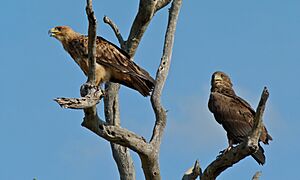
Tawny eagles surprise other birds with a quick dive and snatch their prey. They steal from birds as small as black-winged kites and as large as lammergeiers. They have even stolen from powerful eagles like martial eagles and Verreaux's eagles. They also steal from other meat-eating birds like marabou storks.
Sometimes, tawny eagles lose food to larger eagles like African fish eagles or steppe eagles. Golden eagles can also dominate them. Even small birds like house crows have been seen stealing from tawny eagles!
Reproduction and Life Cycle
Tawny eagles often stay with the same mate for life. They are very protective of their territory. Males and females fly in circles high in the sky to show off and strengthen their bond. Sometimes, two eagles will lock talons and tumble downwards, separating just before hitting the ground. This is part of their courtship display.
The breeding season varies by location. In Africa, it can be from March to August or May to November. In India, it's usually November to May. Mating happens near the nest. Tawny eagles build large nests made of sticks, sometimes with animal bones.
Nests are usually 6 to 15 meters (20 to 50 feet) high in the top of a tree. They are often near watering holes. In India, they might be close to villages. They choose trees with prickly branches for protection. Nests are wide, flat, and shallow. They can be over 1 meter (3.3 feet) wide. Both parents help build and repair the nest.
Eggs and Young Eagles
Eggs are laid a few days apart. They are white, sometimes with faint brown spots. A nest usually has 1 to 3 eggs. The female sits on the eggs for 40–44 days until they hatch. The male sometimes helps.
When they hatch, the chicks are covered in white down. They need to be kept warm or shaded from the sun. At about 3 weeks, they can stand weakly. At 4 weeks, they walk around the nest and start flapping their wings. By 7 weeks, they are mostly feathered.
Usually, only one chick survives. The older chick often harms the younger one, a behavior called siblicide. But sometimes, two young eagles can fledge from one nest. The young eagle takes its first flight around 10–12 weeks old. It stays with its parents for about 6 more weeks, learning to hunt. Sometimes, young eagles stay with their parents until the next breeding season.
Nesting Success
Many young eagles don't survive. Nests can be attacked by predators like corvids, snakes, and climbing carnivores like the honey badger. The success of nesting depends on good habitats and enough food.
In areas with more rainfall, tawny eagles tend to have more successful nests. They can live up to at least 16 years in the wild.
Tawny Eagle Conservation
The tawny eagle still lives in a very large area. Its range in Africa is about 15 million square kilometers (5.8 million square miles). In Asia, it's about 3.1 million square kilometers (1.2 million square miles).
However, the number of tawny eagles has dropped a lot. It's now listed as a Vulnerable species. The world population is much smaller than it used to be. For example, in central Namibia, the population went from 19 pairs down to only 2. In India, where they were once very common, their numbers have also been cut in half.
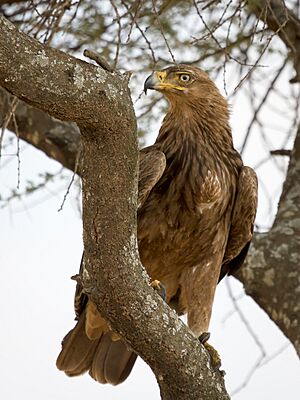
Tawny eagles help other scavengers, like vultures, find food. So, protecting eagles is important for the survival of vultures too.
Threats to Tawny Eagles
Tawny eagles face many dangers.
- Poisoning: One of the biggest threats is poisoning. Poachers sometimes poison animal carcasses to kill scavengers like eagles and vultures. This is because these birds circling above dead animals can alert park rangers to poaching. In 2019, over 500 vultures and 2 tawny eagles died from poisoned elephant carcasses in Botswana.
- Habitat Loss: Their homes are being destroyed by cutting down trees for firewood and charcoal. This is a big problem in India.
- Climate Change: Changes in rainfall patterns due to climate change affect their prey. Less rain means less food, which impacts their breeding success.
- Human Structures: Eagles are often killed by flying into overhead power lines or by cars on roads. They are also at risk from wind turbines in India.
- Human Population Growth: As human populations grow, there is more competition for land and food.
To help tawny eagles survive, we need to stop using poison baits. We also need to make power lines safer for them. And it's very important to fight global warming to protect their habitats.



